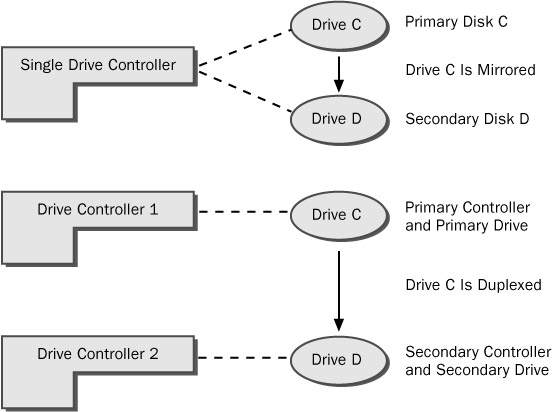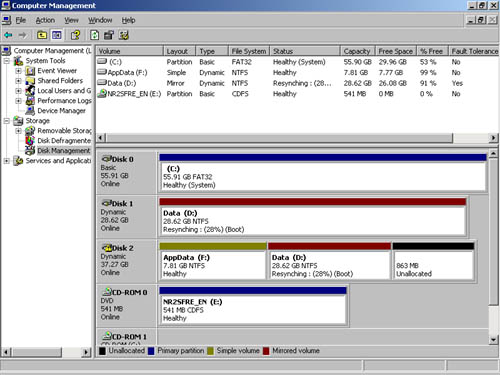Implementing RAID on Windows Server 2003
| Windows Server 2003 supports disk mirroring, disk striping, and disk striping with parity. Implementing these RAID techniques is discussed in the sections that follow. Caution Some operating systems, such as MS-DOS, don't support RAID. If you dual boot your system to one of these noncompliant operating systems, your RAID-configured drives will be unusable. Implementing RAID 0: Disk StripingRAID level 0 is disk striping. With disk striping, two or more volumes ”each on a separate drive ”are configured as a striped set. Data written to the striped set is broken into blocks that are called stripes . These stripes are written sequentially to all drives in the striped set. You can place volumes for a striped set on up to 32 drives, but in most circumstances sets with two to five volumes offer the best performance improvements. Beyond this, the performance improvement decreases significantly. The major advantage of disk striping is speed. Data can be accessed on multiple disks using multiple drive heads, which improves performance considerably. However, this performance boost comes with a price tag. As with volume sets, if any hard disk drive in the striped set fails, the striped set can no longer be used, which means that essentially all data in the striped set is lost. You'll need to recreate the striped set and restore the data from backups . Data backup and recovery is discussed in Chapter 15 , "Data Backup and Recovery." Caution The boot and system volumes shouldn't be part of a striped set. Don't use disk striping with these volumes. When you create striped sets, you'll want to use volumes that are approximately the same size. Disk Management bases the overall size of the striped set on the smallest volume size. Specifically, the maximum size of the striped set is a multiple of the smallest volume size. For example, if the smallest volume is 50 MB, the maximum size for the striped site is 150 MB. To maximize performance of the striped set, you can do several things:
You can create a striped set by doing the following:
Implementing RAID 1: Disk MirroringRAID level 1 is disk mirroring. With disk mirroring, you use identically sized volumes on two different drives to create a redundant data set. Here, the drives are written with identical sets of information and, if one of the drives fails, you can still obtain the data from the other drive. Disk mirroring offers about the same fault tolerance as disk striping with parity. Because mirrored disks don't need to write parity information, they can offer better write performance in most circumstances. However, disk striping with parity usually offers better read performance because read operations are spread out over multiple drives. The major drawback to disk mirroring is that it effectively cuts the amount of storage space in half. For example, to mirror a 5-GB drive, you need another 5-GB drive. That means you use 10 GB of space to store 5 GB of information. Tip If possible, it's a good idea to mirror boot and system volumes. Mirroring these volumes ensures that you'll be able to boot the server in case of a single drive failure. As with disk striping, you'll often want the mirrored disks to be on separate disk controllers. This provides increased protection against failure of the disk controller. If one of the disk controllers fails, the disk on other controller is still available. Technically, when you use two separate disk controllers to duplicate data, you're using a technique known as disk duplexing . Figure 12-5 shows the difference between the two techniques. Where disk mirroring typically uses a single drive controller, disk duplexing uses two drive controllers. Figure 12-5. Although disk mirroring typically uses a single drive controller to create a redundant data set, disk duplexing uses two drive controllers. Other than this, the two techniques are essentially the same. If one of the mirrored drives in a set fails, disk operations can continue. Here, when users read and write data, the data is written to the remaining disk. You'll need to break the mirror before you can fix it. To learn how, see the section of this chapter entitled "Managing RAIDs and Recovering from Failures." Creating a Mirror Set in Disk ManagementYou create a mirror set by completing the following steps:
Mirroring an Existing VolumeRather than creating a new mirrored volume, you can use an existing volume to create a mirrored set. To do this, the volume you want to mirror must be a simple volume and you must have an area of unallocated space on a second dynamic drive of equal or larger space than the existing volume. In Disk Management, you mirror an existing volume by completing the following steps:
Implementing RAID 5: Disk Striping with ParityRAID level 5 is disk striping with parity. With this technique you need a minimum of three hard disk drives to set up fault tolerance. Disk Management sizes the volumes on these drives identically. RAID 5 is essentially an enhanced version of RAID 1 ”with the key addition of fault tolerance. Fault tolerance ensures that the failure of a single drive won't bring down the entire drive set. Instead, the set continues to function with disk operations directed at the remaining volumes in the set. To allow for fault tolerance, RAID 5 writes parity checksums with the blocks of data. If any of the drives in the striped set fails, the parity information can be used to recover the data. (This process, called regenerating the striped set, is covered in the section of this chapter entitled "Managing RAIDs and Recovering from Failures.") If two disks fail, however, the parity information isn't sufficient to recover the data and you'll need to rebuild the striped set from backup. Creating a Striped Set with Parity in Disk ManagementIn Disk Management, you can create a striped set with parity by completing the following steps:
|
EAN: N/A
Pages: 141

